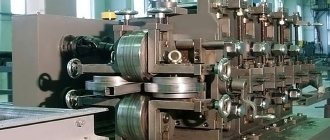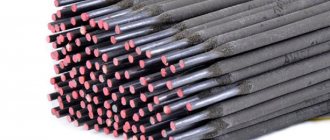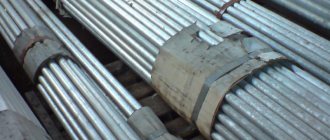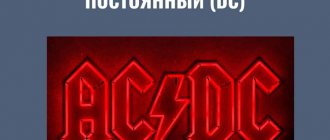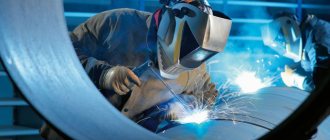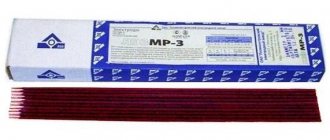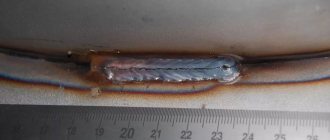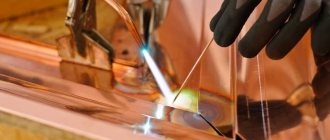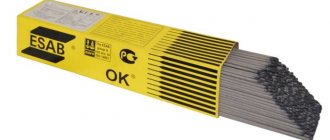22.08
2019
Carbon steels include a class of alloys in which carbon (C) as a chemical element is the main alloying component that determines the most important properties of the metal. Its share in the composition can be different, depending on it, groups of these steels are distinguished:
- low-carbon - the proportion of C in them is less than 0.25%;
- medium-carbon - with a carbon share from 0.25 to 0.6%;
- high-carbon - with a carbon share from 0.6% to 2.07%.
Also, the composition of such steels includes manganese and silicon in very small quantities - as useful alloying elements, and hydrogen and sulfur as harmful impurities.
Features of welding carbon steels
The key requirement when welding parts made of carbon steels is the strength characteristics of the weld metal and heat-affected area: they must correspond to the characteristics of the base metal. The higher the proportion of carbon, the more difficult it is to obtain a compound that strictly meets this requirement. Therefore, each group of carbon steels has its own welding characteristics.
Welding low carbon steels
This is a group of highly weldable, most ductile carbon steels due to their low carbon content and alloying additives. Welding can be performed using any known technologies, including manual electric arc welding.
However, this chemical composition of the metal also causes its own characteristics: if the electrode is chosen incorrectly, there is a risk that the weld metal will be stronger than the metal of the part, which can negatively affect the overall strength of the structure. And when performing multilayer welding, increased fragility of the weld metal is possible.
To avoid these problems, electrodes with rutile and calcium fluoride coatings are usually used for welding, and a proportion of iron powder is added to the coating. Among the low-carbon steels widely used for professional welding are the grades MR-3LUKS, MR-3, OZS-4, ANO-4, ANO-21, OZS-12, MK-46.00, UONI-13/55, UONI 13/45, SSSI 13/85.
To obtain the necessary strength properties, the weld metal is forged and calcined after welding.
ANO-21 STANDARD Current - alternating or direct of any polarity
RUB 203.04 ? with VAT per 1 kg.
MR-3 LUX (NAKS) Current - constant reverse polarity, alternating
180.60 rub. ? with VAT per 1 kg.
MR-3 (NAKS, RRR) Current - alternating or direct, reverse polarity
RUB 171.84 ? with VAT per 1 kg.
OZS-4 (NAKS) Current - alternating or direct polarity (plus on the electrode)
RUB 174.48 ? with VAT per 1 kg.
Electrodes for medium carbon steels
The amount of carbon in such alloys is greater, and accordingly, the welding process is more complicated. The downside is that the metal of the welded joint and the metal of the part may have different strengths. In addition, the metal near the edges of the seam can turn out to be very brittle and with characteristic cracks. To avoid this, electrodes with a sufficiently low carbon content are used.
Particular attention should be paid to the edges of the parts being connected. They must be cut to avoid metal penetration, which can be caused by high currents - they are necessary for heating the parts being connected.
You should also consider:
- to improve the quality of the weld, the parts, as mentioned above, are preheated and heated during the welding process;
- It is better to move the electrode not across, but along the joint;
- welding is best performed with a short arc;
- After welding, for greater strength, the seam is also forged and heat treated.
Among the well-known electrodes that are used for welding medium-carbon steels are grades UONI-13/55, UONII 13/55, UONII 13/45A, UONI-13/65.
Welding high carbon steels
Such steels have a high carbon content, which practically makes them unsuitable for welding various structures. Welding work, as a rule, is performed only when repairs are necessary.
In this case, the same technologies are used as when welding medium-carbon steels. The metal in the weld area is preheated to 250-300 °C; upon completion of welding, the weld is forged and heat treated. Two more conditions must be observed - welding is possible at a temperature not lower than -5 degrees Celsius in a room where there are completely no drafts.
Electrodes for carbon and low alloy steels
The widest range of electrodes is used for welding both carbon and low-alloy steels. This group includes carbon steels with a C content of up to 0.25%, as well as low-alloy steels with a tensile strength of up to 590 MPa. Both have a high carbon content. This reduces the oxidation of the metal and makes it easier to obtain oxide-free compounds. Their plasticity is increased by preliminary heat treatment or subsequent heating.
Both carbon and low-alloy steels have relatively low heat resistance and hardenability.
The share of alloying elements (cobalt, nickel, molybdenum, aluminum, tungsten, copper and others) can reach up to 5% in low-alloy steels. In comparison with carbon materials, they are characterized by a reduced susceptibility to mechanical aging, higher wear resistance, corrosion and cold resistance, and yield strength.
Depending on the proportion of alloying elements, the parameters by which electrodes are selected for welding carbon steels are determined. These parameters include:
- mechanical characteristics of the weld metal;
- required properties of the welded joint;
- temporary tensile strength;
- impact strength;
- relative extension.
ANO-4 (NAKS) Current - alternating or constant of any polarity
RUB 177.84 ? with VAT per 1 kg.
ANO-21 (NAKS) Current - alternating or constant of any polarity
RUB 184.44 ? with VAT per 1 kg.
MK-46.00 (NAKS) Current - constant reverse polarity, alternating
RUB 234.72 ? with VAT per 1 kg.
OZS-12 (NAKS, RRR) Current - alternating or direct polarity
RUB 188.64 ? with VAT per 1 kg.
How to choose the diameter of the electrode depending on the thickness of the metal
When choosing, you should take into account the dependence of the electrode diameter on the thickness of the metal products and elements being welded. The thicker the latter, the correspondingly greater the thickness of the electrode rod. So,
- with a thickness of the welded elements of 1.5-2.5 mm, the thickness of the electrode will be 2-2.5 mm;
- with a thickness of 3 mm - respectively 2.5-3 mm;
- at 4-5 mm - 3-4 mm;
- at 6-10 mm - 4-5 mm.
The permissible welding current values also vary depending on the diameter of the consumable (more on this below). At increased current values (always indicated on the packaging) and exceeding the recommended diameter, there is a risk of pores forming in the weld metal. It should also be said that if the thickness of the products is no more than 1.5 mm, manual arc welding is usually not used.
Electrodes for carbon structural steels
| Brand and type | Purpose and description |
| ANO-4 (E46) | Electrodes with rutile coating for welding structures made of carbon and low-alloy steels with a tensile strength of no more than 451 MPa. Currents - alternating, direct polarity. At high currents they do not form pores. They allow welding over rust and uncleaned edges, and provide easy separation of the slag crust. The deposition rate is 8.5 g/Ah, the consumption per 1 kg of weld weld is 1.7 kg. |
| ANO-6 (E46) | Rutile coated electrodes for alternating and direct current reverse polarity welding of carbon steel structures. The share of carbon in the metal composition is up to 0.25%. Provide easy separation of slag crust. They can operate at elevated conditions and provide a seam without crystallization cracks. The deposition rate is 10 g/Ah, the consumption per 1 kg of deposited weld is 1.6 kg. The ANO-6 grade is recommended for welding under installation conditions. |
| ANO-21 (E46) | Electrodes with rutile coating for alternating and direct current welding of direct and reverse polarity of critical and ordinary structures made of carbon steels in accordance with GOST 380-71 St0, St1, St2, St3 (groups A, B, C, calm, semi-quiet, boiling); according to GOST 1030-74 (10, 15kp, 20kp, 20ps, 20). Able to work on oxidized, galvanic surfaces, and unprepared edges. Easy ignition and arc stability, excellent weld quality. The deposition rate is 9 g/Ah, the consumption per 1 kg of weld weld is 1.7 kg. |
| MR-3 (E46) | Electrodes with a rutile-base coating, grade MP-3, are intended for welding steels with a tensile strength of no more than 500 MPa, the proportion of carbon in them does not exceed 0.25%. Welding is performed with alternating and direct current of reverse polarity. Ensures arc stability and easy re-ignition. Welding - only on a surface free of scale. The deposition rate is 8.5 g/Ah, consumption per 1 kg of deposited weld is 1.7 kg. |
| MR-3S (E46) | Electrodes with a rutile-base coating are used for alternating and direct current reverse polarity welding of carbon steel structures, when increased demands are placed on the quality of the resulting weld. Welding is possible in all spatial positions without exception. Temporary tensile strength - no more than 500 MPa. The deposition rate is 8.5 g/Ah, the consumption per 1 kg of weld weld is 1.7 kg. |
| OZS-4 (E46) | Electrodes with rutile coating are used for alternating and direct current reverse polarity welding of critical structures made of carbon steel (tensile strength up to 490 MPa). Parts of large and small thicknesses are welded equally well. Welding on rusty and wet surfaces is possible. The deposition rate is 8.5 g/Ah, the consumption per 1 kg of weld weld is 1.7 kg. |
| OZS-6 (E46) | For alternating and direct current welding of reverse polarity of structures made of carbon and low-alloy steels with a tensile strength of no more than 451 MPa. They have a rutile (with iron powder) coating. Demonstrate high performance. Welding with an extended arc and over rust is possible. The deposition rate is 10 g/Ah, the consumption per 1 kg of deposited weld is 1.5 kg. |
| OZS-12 (E46) | Electrodes with rutile coating for alternating and direct current reverse polarity welding of carbon and low-alloy structural steels with a tensile strength of no more than 500 MPa. They are optimally suited for welding T-profile joints to produce concave, fine-flaked seams. It is possible to weld with an extended arc and on an oxidized surface without the formation of pores. Welding at extremely low voltage is also allowed. The deposition rate is 8.5 g/Ah, the consumption per 1 kg of weld weld is 1.7 kg. |
| MK-46.00 (E50A) | Universal rutile electrodes for welding with alternating and direct current of any polarity of carbon and low-alloy steels with a temporary resistance of up to 450 MPa. Widely used for welding sheet and pipe structures. Creates reduced heat input. Well suited for tack welding, welding short and root seams. Not sensitive to rust and surface contamination. Welding is possible in all spatial positions. The deposition rate is 8.5 g/Ah, the consumption per 1 kg of weld weld is 1.7 kg. |
| OK-48.00 (E50A) | Universal welding electrodes with a basic coating for welding ship steels, critical structures with operating conditions at low temperatures and high alternating loads. Provide a minimum hydrogen content in the deposited metal. Welding is possible with direct and alternating current of reverse polarity. Ideal for welding wear-resistant Hardox steels. |
| UONI-13/45 (E42A) | Electrodes with the main type of coating for direct current reverse polarity welding of especially critical structures with increased requirements for metal in terms of ductility and impact toughness. The tensile strength of steel is up to 490 MPa. Recommended for welding structures operated in low-temperature conditions, as well as for welding pipe joints in deposits with high hydrogen sulfide content. The deposition rate is 9 g/Ah, the consumption per 1 kg of deposited weld is 1.6 kg. |
| UONI-13/55 (E50A) | Electrodes with basic coating for direct current reverse polarity welding of especially critical structures made of carbon and low-alloy steels. Allows you to obtain weld metal that is resistant to the formation of crystallization cracks. Due to this, they are used for welding structures operating at low temperatures and alternating loads. The deposition rate is 9.5 g/Ah, the consumption per 1 kg of weld weld is 1.65 kg. |
| UONI-13/55U (E55) | Electrodes with a basic coating for manual arc welding with alternating and direct current of reverse polarity of critical structures, as well as wet welding of rails and reinforcement of reinforced concrete structures made of steel grades: ST5, 18G2S, 15GS and others. The deposition rate is 10 g/Ah, the consumption per 1 kg of deposited weld is 1.6 kg. |
| UONI-13/55R (E50A) | Electrodes with basic coating for direct current reverse polarity welding of ship steels with a yield strength of up to 390N/mm2 (categories A, B, D, A32, A36, D32, D36, D40, E40 according to GOST R 52927-2008 and the Rules of the Russian Maritime Register of Shipping ). Used for welding T-joints and butt joints. Manufactured under the supervision of the Russian Maritime Register of Shipping. The deposition rate is 9 g/Ah, the consumption per 1 kg of weld weld is 1.7 kg. |
| UONI-13/65 (E60) | Electrodes with basic coating for DC reverse polarity welding of mechanical engineering structures designed for heavy loads. Temporary tensile strength of steels up to 588 MPa. The deposition rate is 9 g/Ah, the consumption per 1 kg of deposited weld is 1.6 kg. |
| TMU-21U (E50A) | Electrodes with basic coating for direct current reverse polarity welding of critical structures and pipelines used in nuclear, electrical and thermal energy. The deposition rate is 9 g/Ah, the consumption per 1 kg of deposited weld is 1.6 kg. |
| TsU-5 (E50A) | Electrodes with basic coating for DC welding of tank elements, pipe equipment, boiler units. Allows welding of root seams of thick-walled pipelines used at energy facilities. The maximum operating temperature of welded joints is up to 400°C. The deposition rate is 9.5 g/Ah, the consumption per 1 kg of weld weld is 1.7 kg. |
What are the methods for welding professional pipes 20x40 and similar sizes?
The following main widespread welding technologies are used for welding profile pipes:
- electric arc;
- gas;
- contact
The process of performing electric arc welding in accordance with safety requirements, in particular, with the use of personal protective equipment
Next, we will consider in more detail the electric arc welding method, in which the same electrodes that determine the subject of the article are used as consumables. But first, let's look at the alternatives. The description of other methods of welding profile pipes will be brief and very general.
Electric arc
It is possible to weld profile pipes using electric arc technology using both manual and mechanized methods.
Manual arc welding of profile pipes is carried out using transformer or inverter machines . The light weight of the equipment and simple connection to the power source allows welding to be carried out in the most inaccessible places.
Transformer welding machines operate on alternating current. This intermittent supply of energy to the welding zone creates problems in ensuring stable arc operation. It is quite difficult for a novice welder to set up a transformer . Welding thick products is not a problem for a welding transformer.
Inverter
An inverter welding machine is inferior in power to a transformer welding machine. It is not always designed to weld thick metals, at least not every model . However, its electronic circuits provide a stable direct current output , which ensures a stable arc and minimizes spatter of the metals being welded. Smoother regulation of the welding current and the presence of special options such as “ANTI STICK” (prevent electrode sticking), “ARC FORCE” (welding arc force) will greatly help novice welders when welding profile pipes with thin walls.
An inverter welding machine provides several advantages for the novice welder when working with profile pipes, in particular, it provides a stable current, which avoids burn-throughs
To weld large metal structures from profile pipes, semi-automatic mechanized welding is often used. When using an inverter as a power source, thin walls can be welded, since the welding process will automatically support pre-selected modes of wire feed speed, welding current, output voltage and shielding gas flow. Basically, to reduce the cost of mechanized technology for welding profile pipes, carbon dioxide is used, rarely argon (for welding profile pipes made of stainless steel). The presence of shielding gas cylinders limits the mobility of welding equipment.
Gas
In the absence of electricity, profile pipes can be connected using gas welding. A molten filler wire is fed into the area where the edges are , which forms a welding seam after solidification. Heating of the wire to a melting state is provided by an oxygen-acetylene gas mixture, the combustion temperature of which turns it into a liquid state. For welding profile pipes with thin walls, gas welding may be preferable to electric arc welding, since it practically eliminates such a defect as burn-through.
Products produced by the Magnitogorsk Electrode Plant
Magnitogorsk Electrode Plant produces electrodes for welding high-carbon, medium- and low-carbon steels. Electrodes allow you to weld any structures made from these materials - from non-critical ones for repairs or for domestic use to especially critical ones made from high-strength steels designed for high loads.
You can buy electrodes for carbon steels on our website. We offer our own products, so our prices are among the lowest in the region. All goods are certified in the GOST R system, which is confirmed by accompanying documents.
Standards
Electrodes for carbon steels that provide welding of heat-resistant and structural alloys must comply with GOST (u) 9467-75.
Welding electrodes manufactured for:
- deposition of alloy surfaces is regulated by GOST (ohm) 10051-75;
- welding of high-alloy alloys with special properties corresponds to GOST (u) 10052-75.
Each foreign brand of American and European standards corresponds to a domestic brand according to GOST (u).
